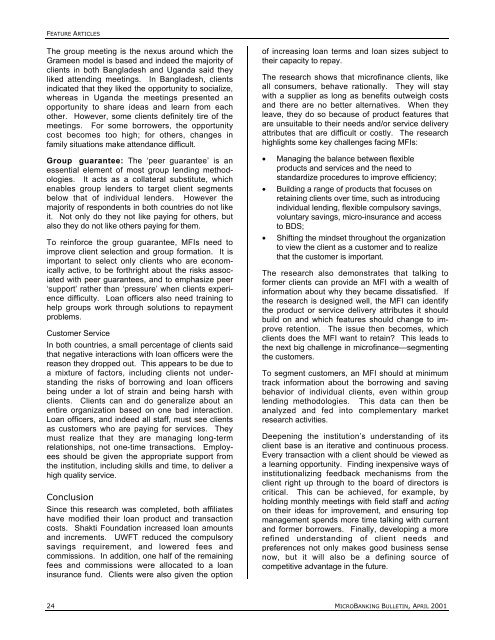the microbanking bulletin - Microfinance Information Exchange
the microbanking bulletin - Microfinance Information Exchange
the microbanking bulletin - Microfinance Information Exchange
You also want an ePaper? Increase the reach of your titles
YUMPU automatically turns print PDFs into web optimized ePapers that Google loves.
FEATURE ARTICLESThe group meeting is <strong>the</strong> nexus around which <strong>the</strong>Grameen model is based and indeed <strong>the</strong> majority ofclients in both Bangladesh and Uganda said <strong>the</strong>yliked attending meetings. In Bangladesh, clientsindicated that <strong>the</strong>y liked <strong>the</strong> opportunity to socialize,whereas in Uganda <strong>the</strong> meetings presented anopportunity to share ideas and learn from eacho<strong>the</strong>r. However, some clients definitely tire of <strong>the</strong>meetings. For some borrowers, <strong>the</strong> opportunitycost becomes too high; for o<strong>the</strong>rs, changes infamily situations make attendance difficult.Group guarantee: The ‘peer guarantee’ is anessential element of most group lending methodologies.It acts as a collateral substitute, whichenables group lenders to target client segmentsbelow that of individual lenders. However <strong>the</strong>majority of respondents in both countries do not likeit. Not only do <strong>the</strong>y not like paying for o<strong>the</strong>rs, butalso <strong>the</strong>y do not like o<strong>the</strong>rs paying for <strong>the</strong>m.To reinforce <strong>the</strong> group guarantee, MFIs need toimprove client selection and group formation. It isimportant to select only clients who are economicallyactive, to be forthright about <strong>the</strong> risks associatedwith peer guarantees, and to emphasize peer‘support’ ra<strong>the</strong>r than ‘pressure’ when clients experiencedifficulty. Loan officers also need training tohelp groups work through solutions to repaymentproblems.Customer ServiceIn both countries, a small percentage of clients saidthat negative interactions with loan officers were <strong>the</strong>reason <strong>the</strong>y dropped out. This appears to be due toa mixture of factors, including clients not understanding<strong>the</strong> risks of borrowing and loan officersbeing under a lot of strain and being harsh withclients. Clients can and do generalize about anentire organization based on one bad interaction.Loan officers, and indeed all staff, must see clientsas customers who are paying for services. Theymust realize that <strong>the</strong>y are managing long-termrelationships, not one-time transactions. Employeesshould be given <strong>the</strong> appropriate support from<strong>the</strong> institution, including skills and time, to deliver ahigh quality service.ConclusionSince this research was completed, both affiliateshave modified <strong>the</strong>ir loan product and transactioncosts. Shakti Foundation increased loan amountsand increments. UWFT reduced <strong>the</strong> compulsorysavings requirement, and lowered fees andcommissions. In addition, one half of <strong>the</strong> remainingfees and commissions were allocated to a loaninsurance fund. Clients were also given <strong>the</strong> optionof increasing loan terms and loan sizes subject to<strong>the</strong>ir capacity to repay.The research shows that microfinance clients, likeall consumers, behave rationally. They will staywith a supplier as long as benefits outweigh costsand <strong>the</strong>re are no better alternatives. When <strong>the</strong>yleave, <strong>the</strong>y do so because of product features thatare unsuitable to <strong>the</strong>ir needs and/or service deliveryattributes that are difficult or costly. The researchhighlights some key challenges facing MFIs:• Managing <strong>the</strong> balance between flexibleproducts and services and <strong>the</strong> need tostandardize procedures to improve efficiency;• Building a range of products that focuses onretaining clients over time, such as introducingindividual lending, flexible compulsory savings,voluntary savings, micro-insurance and accessto BDS;• Shifting <strong>the</strong> mindset throughout <strong>the</strong> organizationto view <strong>the</strong> client as a customer and to realizethat <strong>the</strong> customer is important.The research also demonstrates that talking toformer clients can provide an MFI with a wealth ofinformation about why <strong>the</strong>y became dissatisfied. If<strong>the</strong> research is designed well, <strong>the</strong> MFI can identify<strong>the</strong> product or service delivery attributes it shouldbuild on and which features should change to improveretention. The issue <strong>the</strong>n becomes, whichclients does <strong>the</strong> MFI want to retain? This leads to<strong>the</strong> next big challenge in microfinance—segmenting<strong>the</strong> customers.To segment customers, an MFI should at minimumtrack information about <strong>the</strong> borrowing and savingbehavior of individual clients, even within grouplending methodologies. This data can <strong>the</strong>n beanalyzed and fed into complementary marketresearch activities.Deepening <strong>the</strong> institution’s understanding of itsclient base is an iterative and continuous process.Every transaction with a client should be viewed asa learning opportunity. Finding inexpensive ways ofinstitutionalizing feedback mechanisms from <strong>the</strong>client right up through to <strong>the</strong> board of directors iscritical. This can be achieved, for example, byholding monthly meetings with field staff and actingon <strong>the</strong>ir ideas for improvement, and ensuring topmanagement spends more time talking with currentand former borrowers. Finally, developing a morerefined understanding of client needs andpreferences not only makes good business sensenow, but it will also be a defining source ofcompetitive advantage in <strong>the</strong> future.24 MICROBANKING BULLETIN, APRIL 2001
















